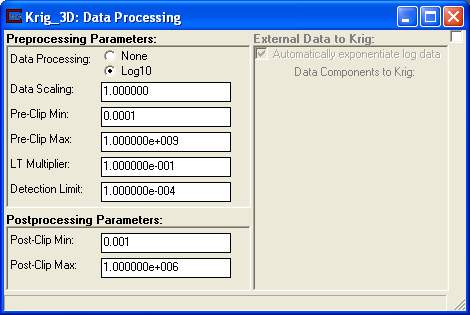
It is important to understand how to properly handle samples that are classified as non-detects. A non-detect is an analytical sample where the concentration is deemed to be lower than could be detected using the method employed by the laboratory.
Non-detects should never be left out of the data file. They are critically important in determining the spatial extent of the contamination. Furthermore, it is important to understand what it means to have a sample that is not-detected. It is not the same as truly ZERO, or perfectly clean. In some cases samples may be non-detects but the detection limit may be so high that the sample should not be used in your data file.
As for WHY to use a fraction of the detection limit. At each point where a measurement was made and the result was a non-detect, we should use a fraction of the detection limit (such as one-tenth). If we were to use the detection limit, we would dramatically overestimate the actual concentrations. From a statistical point of view, when we have a non-detect on a site where the range of measurements varies over several orders of magnitude, it is far more probable that the actual measurement will be dramatically lower than the detection limit than just below it.
Non-detects are accommodated in EVS/MVS for analysis and visualization using a few very important parameters that should be well understood and carefully considered. These parameters control the clipping non-detect handling in all of the EVS modules that read chemistry (.apdv, or .aidv) files. The affected modules are Krig_3D, Krig_2D, Krig_Fence, post_samples, and file_statistics.
The parameters you need to understand (and perhaps modify) are:
The number entered into the Pre-Clip Min input field will be used during preprocessing to replace any nodal property value that is less than the specified number. When log processing is being used, the value of Clip Min must be a positive, non-zero value. Generally, Clip Min should be set to a value that is one-half to one-tenth of the lowest detection limit in the data set, unless the user wishes to make the influence of not detected values stronger. As an example, if the lowest detection limit is 0.1 (which is present in the data set as a 0), and the user sets Clip Min to 0.0001, the clipped non-detected values forces three orders of magnitude to be present between any detected value and the non-detected values.
The Post-Clip Min parameter specifies the smallest nodal value that will be present in the data field output by Krig_3D. This parameter is useful for limiting or enhancing the effects of not detected values or outliers in a data set, and for optimizing the use of the dynamic color range used to represent the property distribution. Clip Min has a default value of 0.001, but can be set to any negative or positive value with magnitudes from -1.0 E09 to 1.0 E09. In general, good results are obtained by setting this value to the lowest property value or detection limit in the input data set. It is important to note that because not detected values are represented in the .apdv file as zeros, the Clip Min value can be used to strengthen the influence of small values or non-detects that are present in the data set. As an example, if the detection limit for a certain chemical analysis is 0.1 (which is entered into the .apdv file as 0), and the Clip Min is set to 0.0001, then this not detected value will have an effective influence on the kriged distribution near this data point that is three orders of magnitude stronger than the actual detection limit. The user should bear in mind that if mass or volume estimates are being made in the analysis, the Clip Min value could affect the estimates if considerable data are present that are being clipped. For volume estimates, if the specified lower bound of the concentrations of interest is well above the Clip Min value, then their will be no effects on the results. If the specified lower bound of concentrations for the volume estimate is lower than Clip Min, then the clipping will truncate the volume at the Clip Min value, and the estimated volume will be from the entire model domain.
The LT Multiplier value affects any file value with a preceeding "<" character. It will multiply these values by the set value.
The Detection Limit value affects any file values set with the "ND" or other non-detect flags (for a list of these flags open the help for the APDV file format). When the module encounters this flag in the file it will insert the a value equal to (Detection Limit * LT Multiplier).
The Data Processing panel for Krig_3D is shown below as an example.

© 1994-2018 ctech.com